Physical Address
304 North Cardinal St.
Dorchester Center, MA 02124
Blisters, which are clinically subdivided into vesicles (L. vesicula , dim. of vesica , bladder) and bullae (L. bubble), are defined as accumulations of fluid either within or below the epidermis and mucous membranes. Although somewhat arbitrary, the term ‘vesicle’ is applied to lesions less than 0.5 cm in diameter and ‘bulla’ to those greater than 0.5 cm. Subepidermal blisters, i.e., those that develop at the epidermal or mucosal basement membrane region, include inherited variants and acquired (often autoimmune mediated) conditions. The former are usually classified as noninflammatory (cell-poor) blisters whereas the latter are commonly inflammatory (cell-rich) in nature ( Fig. 4.1 ).
Subepidermal blisters may develop within the lower epidermis, the lamina lucida (e.g., bullous pemphigoid) or deep to the lamina densa (e.g., epidermolysis bullosa acquisita) ( Fig. 4.2 ). In addition to clinical observations, the precise diagnosis of a blistering disorder requires careful histologic and immunofluorescence correlation. When possible, the last should include indirect studies and, in particular, NaCl-split skin should be used as substrate as a mechanism of localizing the site of dermal–epidermal separation. If a sample has not been taken for indirect immunofluorescence, immunoperoxidase antigen mapping on paraffin-embedded material may on occasions be of value at least as a screening procedure. Although the results of electron microscopic investigations and, in particular, molecular studies have formed the basis of the current classification of subepidermal bullous dermatoses, such techniques are usually not essential to the everyday investigation of a patient with an acquired blistering disorder.
The mechanisms involved in the development of a subepidermal blister are variable. They include inherited mutational defects of basement membrane proteins, i.e., epidermolysis bullosa, acquired autoimmune bullous diseases such as bullous pemphigoid, cellular immunity-mediated disorders (e.g., erythema multiforme and toxic epidermal necrolysis), metabolic diseases including porphyria cutanea tarda, and profound subepidermal edema, such as may be seen in bullous arthropod bite reactions and dermal acute inflammatory processes (e.g., Sweet disease).
In this chapter, only those conditions in which subepidermal blister formation represents an inherited or autoimmune primary event are considered. Other conditions that may be associated with subepidermal blistering are dealt with in more appropriate chapters.
This technique represents a modification of indirect immunofluorescence (IIMF) where normal skin is split through the lamina lucida of the basement membrane region to produce an artificial blister cavity (with the lamina densa lining the floor) for use as substrate. Artificial separation can be achieved by the suction technique (in vivo) or by immersion of normal skin in 1 M NaCl for 48 hours at 4°C ( Fig. 4.3 ). In general, the latter technique is preferred. As such a split is invariably through the lamina lucida region (confirmed by electron microscopy or immunofluorescence) ( Figs 4.4 and 4.5 ), the technique enables precise localization of a circulating basement membrane zone antibody to either the floor or the roof of the artificial blister cavity. In bullous pemphigoid, pemphigoid gestationis, and the majority of cases of mucous membrane pemphigoid, linear immunofluorescence is found along the roof of the artificial blister whereas in diseases characterized by a sublamina densa split (e.g., epidermolysis bullosa acquisita, antilaminin mucous membrane pemphigoid, anti-p105 pemphigoid, anti-p200 pemphigoid, and bullous dermatosis of bullous lupus erythematosus), the immunofluorescent signal is found along the floor of the blister (see references and for a review) ( Fig. 4.6 ). In some diseases, positive immunofluorescence may be found on either the roof or the floor or even at both sites simultaneously (e.g., linear IgA disease and some variants of mucous membrane pemphigoid). Such variable labeling reflects the antigen heterogeneity in a number of bullous dermatoses.
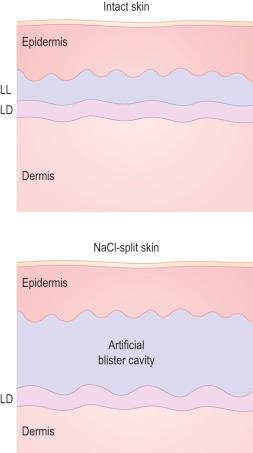
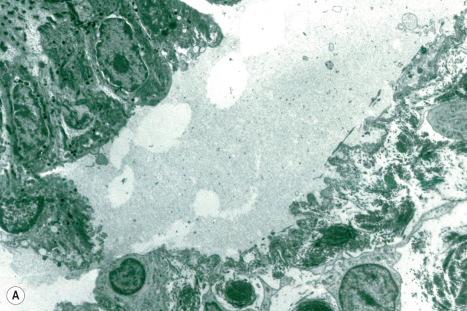
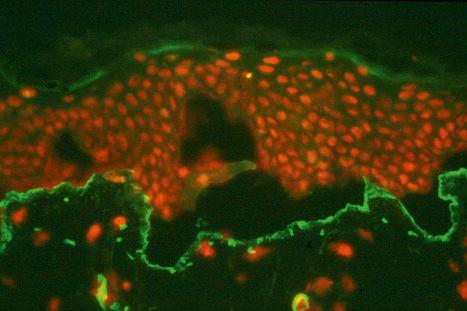
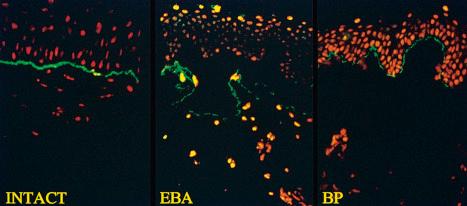
As an alternative to split skin immunofluorescence, paraffin-embedded sections of lesional skin have been proposed in a direct immunoperoxidase antigen mapping technique to identify the level of the dermal–epidermal separation. This procedure localizes known basement membrane region constituents such as keratins 5/14, laminin, and type IV collagen to the roof or floor of the blister cavity. The site of blister formation can therefore be characterized as intrabasal, within the lamina lucida or deep to the lamina densa. For example, in epidermolysis bullosa simplex variants, all of these immunoreactants are present along the floor of the blister cavity. In bullous pemphigoid, keratin is present along the roof of the blister while laminin and type IV collagen are found along the floor ( Fig. 4.7 ). In dystrophic epidermolysis bullosa, epidermolysis bullosa acquisita, and bullous systemic lupus erythematosus, all three immunoreactants are present in the roof of the blister ( Fig. 4.8 ). However, in many hereditary and acquired blistering diseases the relevant antibodies against the target antigens do not work well in paraffin-embedded material and false-positive and false-negative results are common, making this method unreliable for use in routine diagnosis. For example, antigen mapping of the group of hereditary subepidermal blistering diseases is done exclusively on frozen sections with excellent results.
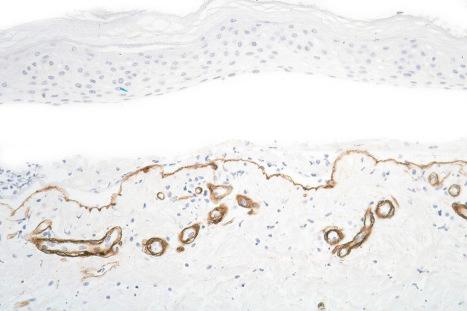
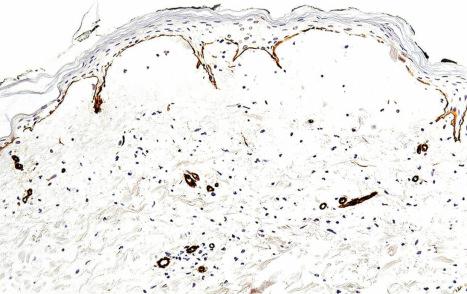
Epidermolysis bullosa (EB) refers to a heterogeneous group of diseases in which the skin and sometimes the mucous membranes blister easily in response to mild trauma, hence the alternative title ‘mechanobullous disease’, which has sometimes been applied. Indeed, the descriptive term epidermolysis is somewhat illogical because epidermal disruption is not the primary change in several categories of EB. Nevertheless, the name epidermolysis bullosa , as originally used by Koebner in 1886, is now so well established in the literature that it remains the accepted term. All forms of EB are rare; it is estimated that globally about 500 000 people have EB.
Historically, the classification of EB has been difficult and not helped by the large variety of names and eponyms that have traditionally been used. While these early observations were important in establishing EB as an entity, a major step forward was made by Pearson in the 1960s, who used transmission electron microscopy to show that the ultrastructural level of tissue cleavage (blister formation) in the skin is distinctive in the three major groups of EB: intraepidermal in EB simplex, through the lamina lucida in junctional EB, and below the lamina densa in dystrophic EB (although a separate fourth category, Kindler syndrome, has subsequently been added in which there is a variable mixed level of blistering). Indeed, these different levels of cleavage still form the basis of the current classification of EB ( Table 4.1 ). Since Pearson's initial observations, the concept and content of EB simplex has also expanded with the addition of more superficial skin fragility disorders, including inherited disorders of desmosomes as well as cornification ( Table 4.2 ). Likewise, the classification of the junctional and dystrophic forms of EB has also evolved, although the multiple variants thereof have largely been defined by clinical features ( Tables 4.3 and 4.4 ). Although the clinicopathologic entities now regarded as forms of EB have expanded, most of the major forms of EB occur at or close to the dermal–epidermal junction, and a schematic of the key proteins and genes implicated in these forms of EB is shown in Fig. 4.9 .
| Level of skin cleavage | EB type | EB subtype | Defective protein(s) |
|---|---|---|---|
| Intraepidermal | EB simplex | Suprabasal EB simplex | Transglutaminase-5; Plakophilin-1; Desmoplakin; Plakoglobin |
| Basal EB simplex | Keratins 5 and 14; Plectin; Exophilin-5; 230-kDa bullous pemphigoid antigen/dystonin | ||
| Intralamina lucida | Junctional EB | Junctional EB generalized | Laminin-332; Type XVII collagen α6, β4, α3 integrin subunits |
| Junctional EB localized | Type XVII collagen; Laminin-332; α6, β4 integrin subunits | ||
| Sublamina densa | Dystrophic EB | Dominant Dystrophic EB | Type VII collagen |
| Recessive Dystrophic EB | Type VII collagen | ||
| Mixed | Kindler syndrome | Kindlin-1 (Fermitin family homologue-1) |
| EB simplex type | EB simplex subtype | Targeted protein(s) |
|---|---|---|
| Suprabasal | Acral peeling skin syndrome | Transglutaminase-5 |
| EB simplex superficialis | Unknown | |
| Ectodermal dysplasia-skin fragility syndrome | Plakophilin-1 | |
| Severe acantholytic EB | Desmoplakin a , Plakoglobin a | |
| Basal | EB simplex – localized b | Keratins 5 and 14 |
| EB simplex – generalized severe | Keratins 5 and 14 | |
| EB simplex – generalized intermediate | Keratins 5 and 14 | |
| EB simplex – mottled pigmentation | Keratin 5 | |
| EB simplex – migratory circinate | Keratin 5 | |
| EB simplex – autosomal recessive (K14) | Keratin 14 | |
| EB simplex – autosomal recessive (BP230) | 230 kDa Bullous pemphigoid antigen | |
| EB simplex – autosomal recessive (exophilin-5) | Exophilin-5 | |
| EB simplex – muscular dystrophy | Plectin | |
| EB simplex – muscular dystrophy | Plectin; α6, β4 integrin subunits | |
| EB simplex – Ogna | Plectin |
a Although listed as being associated with suprabasal subtypes of EB simplex, desmoplakin and plakoglobin show that pan-epidermal expression and mutations in these proteins affect basal as well as suprabasal keratinocytes.
b Occasionally, this type of EB simplex can also result from mutations in plectin, type XVII collagen and the β4 integrin subunit.
| Junctional EB type | Junctional EB subtype | Targeted protein(s) |
|---|---|---|
| Generalized | Severe | Laminin-332 |
| Intermediate | Laminin-332; Type XVII collagen | |
| Late onset | Type XVII collagen | |
| With pyloric atresia | α6 and β4 integrin subunits | |
| With respiratory and renal involvement | α3 integrin subunit | |
| Localized | Localized | Laminin-332; Type XVII collagen, α6 and β4 integrin subunits |
| Inversa | Laminin-332 | |
| Laryngo-onycho-cutaneous syndrome | Laminin α3a |
| Dystrophic EB type a | Dystrophic EB subtype |
|---|---|
| Dominant | Generalized |
| Acral | |
| Pretibial | |
| Pruriginosa | |
| Nails only | |
| Bullous dermolysis of the newborn | |
| Recessive | Generalized severe |
| Generalized intermediate | |
| Inversa | |
| Localized | |
| Pretibial | |
| Pruriginosa | |
| Centripetalis | |
| Bullous dermolysis of the newborn |
a The targeted protein in all types and subtypes of dystrophic EB is type VII collagen.
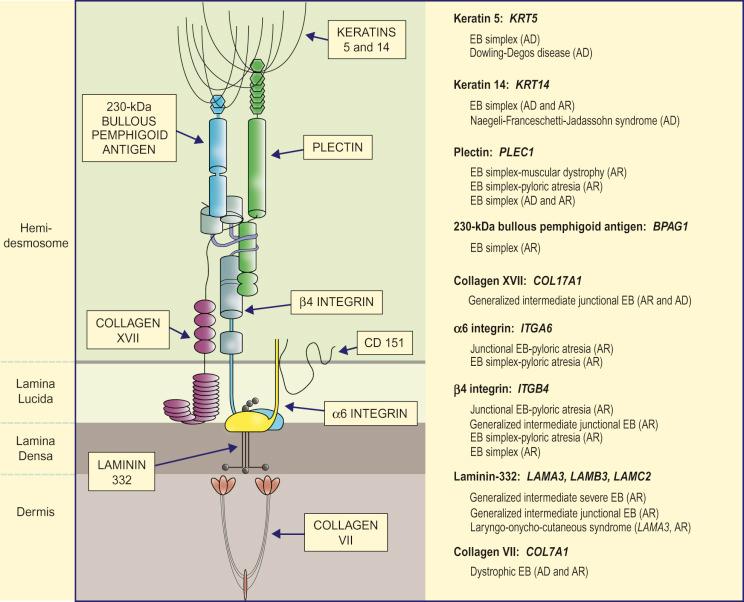
In addition to establishing specific levels of blistering in the different subtypes of EB, ultrastructural studies were also able to identify distinct morphologic abnormalities, such as keratin filament disruption in EB simplex, poorly formed hemidesmosomes in junctional EB, and rudimentary anchoring fibrils in dystrophic EB. During the 1980s, the immunohistochemical labeling of EB skin with basement membrane zone antibodies became a useful diagnostic addition, for example showing reduced immunostaining for proteins such as laminin-332 in some forms of junctional EB, and type VII collagen in recessive dystrophic EB, respectively. Then in the 1990s, the discovery of candidate genes and pathogenic mutations, such as mutations in KRT14 and KRT5 in EB simplex (keratins 14 and 5) and COL7A1 in dystrophic EB (type VII collagen), heralded the era of molecular diagnostics. Reflecting these advances at electron microscopic, immunohistochemical, and molecular levels, the classification of EB has evolved over the years with the most recent international consensus report (published in 2014) recommending abandonment of most historical eponyms and adoption of an “onion skin” approach to disease nomenclature – the different layers referring to the methods of diagnostic evaluation available – clinical phenotype, mode of transmission, level of split in the skin, immunohistochemistry, mutation detection, etc. For example, a patient with intraepidermal blister formation, blistering confined to the palms and soles, and a family history consistent with autosomal dominant transmission would initially be classified as having localized EB simplex. Once mutational confirmation is completed, the final diagnosis, using the onion skin method, would be: EB simplex, localized, KRT5 mutation (missense mutation). It is believed that this format for diagnosing EB provides both practical and academic value in classifying EB, although it is likely to be revised further in years to come as more discoveries are made.
Molecular studies have now identified pathogenic mutations in 18 different genes in the heterogeneous clinical subtypes of EB ( Table 4.5 ). With regard to diagnosing EB, sequencing of patient DNA (either Sanger sequencing or next generation sequencing using whole exome sequencing or selected gene panels) is gradually emerging as a primary investigation with the role of skin biopsy somewhat diminishing. This is certainly true for autosomal dominant forms of EB simplex or dominant dystrophic EB in which the skin pathology (both ultrastructural and immunohistochemical) may not differ significantly from normal skin, especially if no fresh blister is included in the biopsy. Nevertheless, skin biopsy remains a useful means of rapidly diagnosing autosomal recessive forms of EB, which is particularly useful in neonates with fragile skin since prompt diagnosis has important implications for optimal clinical management of affected babies and their families. Details about the most appropriate skin biopsy techniques and investigations for diagnosing EB are presented in Chapter 2 .
| EB type | EB subtype | Mutated genes |
|---|---|---|
| EBS | EBS, suprabasal | TGM5 |
| DSP | ||
| PKP1 | ||
| JUP | ||
| EBS, basal | KRT5 | |
| KRT14 | ||
| EXPH5 | ||
| PLEC | ||
| DST | ||
| JEB | JEB, severe generalized | LAMA3 |
| LAMB3 | ||
| LAMC2 | ||
| JEB, generalized/localized | LAMA3 | |
| LAMB3 | ||
| LAMC2 | ||
| COL17A1 | ||
| ITGB4 | ||
| JEB, late onset | COL17A1 | |
| JEB with pyloric atresia | ITGB4 | |
| ITGA6 | ||
| JEB with respiratory and renal involvement | ITGA3 | |
| JEB-LOC syndrome | LAMA3A | |
| DEB | RDEB, severe generalized | COL7A1 |
| RDEB, generalized and localized | COL7A1 | |
| DDEB (all subtypes) | COL7A1 | |
| KS | Kindler syndrome | FERMT1 (KIND1) |
For the dermatopathologist, a key issue will always be whether EB is best classified by skin/molecular pathology or by clinical morphology, and therefore in the sections that follow, both options are presented. Another important issue is how best to diagnose EB with the material made available. For skin that has been formalin-fixed and embedded in paraffin, successful diagnosis may depend on the presence or absence of a fresh blister. Most clinicians are aware that biopsying a blister that has been present for more than 12 hours is likely to present the pathologist with difficulties in determining the true plane of cleavage because of re-epithelialization and therefore rubbed non-blistered skin is preferentially sampled (see Chapter 2 ). Antigen mapping and immunoperoxidase staining is possible with antibodies to type IV collagen, which determines whether the lamina densa is present in the roof (dystrophic EB) or base (EB simplex and junctional EB) of the blister. Immunodiagnosis is also possible using selective probes, such as type VII collagen (reduced in recessive dystrophic EB). Nevertheless, the majority of the antibodies used to diagnose EB target transmembranous proteins and therefore work suboptimally (or not at all) on paraffin-embedded skin sections. For EB diagnostics, skin immunohistochemistry is best performed on frozen sections (see Chapter 2 ). Part of the diagnostic skin biopsy is often fixed and processed for transmission electron microscopy although oftentimes sections are only cut if the skin immunolabeling fails to establish a diagnosis. Over the last decade, therefore, with the increasing utility of antibodies to skin basement membrane and epithelial proteins, the number of EB skin biopsies requiring transmission electron microscopy to establish a diagnosis has reduced by over 50%. This number is likely to decrease further as molecular diagnostics become more widely available, cheaper and quicker. Immunoelectron microscopy is not performed for routine EB diagnostics and is mainly used for research, including translational research when evaluating clinical trials of cell and gene-based therapies.
The subtypes of EB simplex are subdivided into basal and suprabasal variants, that manifest as at least 15 distinct clinical disorders ( Table 4.2 ).
This is the most common type of EB. Inheritance is autosomal dominant. The soles and palms ( Fig. 4.10 ) are mainly affected. The condition is typically worse in warm weather. Hyperhidrosis of the feet is common; this increases friction, which also exacerbates blistering. The blisters usually heal without scarring or milia formation. Calluses are very common, especially in adults. Oral blistering occurs in less than 25% of cases. The hair and teeth are normal.
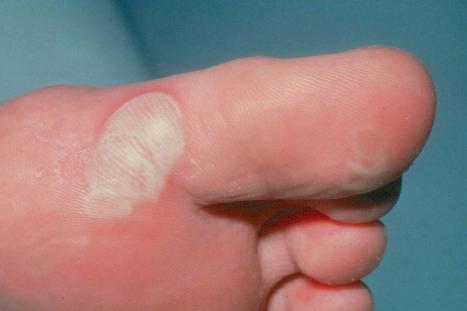
A differential diagnosis of localized autosomal dominant EB simplex is autosomal recessive acral peeling skin syndrome, although both are classified as forms of EB simplex. Blisters typically occur on the feet but are often more evident on the sides or dorsal aspects of the toes ( Fig. 4.11 ). The level of blistering occurs above the granular layer, but because of the thicker stratum corneum in acral skin the clinical consequences may be almost identical to blistering through the basal keratinocyte layer.
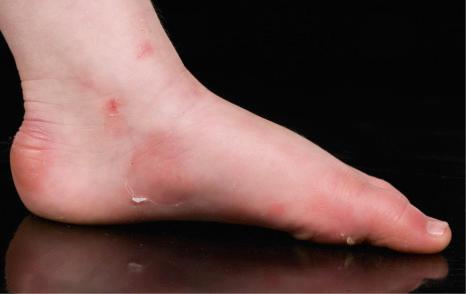
A further common subtype of EB simplex is the generalized severe variant, previously known as Dowling-Meara EB simplex. Inheritance is autosomal dominant. Blisters tend to occur in groups, hence the earlier use of the term EB herpetiformis ( Fig. 4.12 ). In infancy, blistering may be severe with involvement of the mucous membranes, shedding of nails, and formation of milia. The distinctive feature is spontaneous herpetiform, annular or arcuate blistering on the trunk, limbs, and neck. Irregular hyperkeratosis of the palms and soles or keratoderma is often present. The general condition tends to improve with age.
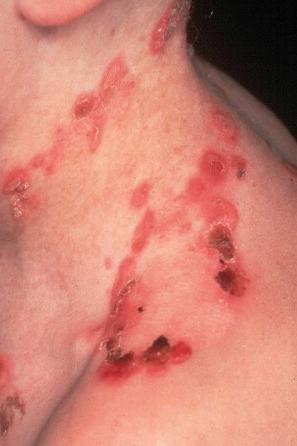
This subtype of EB includes inherited blistering previously known as Koebner EB simplex. Most cases are autosomal dominant. Although usually mild, approximately 60% of patients have localized scarring and approximately 15% have milia. The development of hair, teeth, and nails is normal. Blisters appear within the first year and may be present at birth. In infancy, they commonly appear on the occiput, back, and legs, while in childhood the hands and feet are often affected, although the palms and soles are not preferentially involved, as in localized EB simplex. In common with other forms of EB simplex, blistering is worse in warm weather.
Distinction from other forms of EB simplex is made by the presence of pigmentary changes, which are present at birth or appear during infancy. There is a reticulate pattern of small, tan-colored macular lesions, which may spread from acral sites to the trunk and which fade with age ( Fig. 4.13 ). They may cover the entire skin surface, but preferentially involve the neck, upper trunk, or extremities. Blistering may be localized, or become more generalized. Most cases result from a specific heterozygous missense mutation in keratin 5.
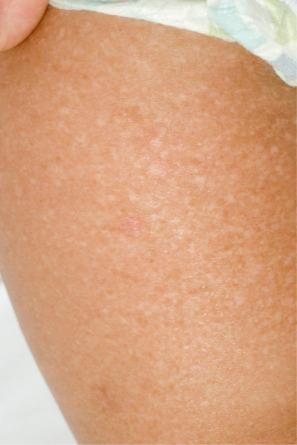
This autosomal dominant condition was named after the village in Norway where the first affected family originated. There is seasonal blistering of the hands and feet, and occasionally elsewhere. This rare subtype of EB is distinguishable clinically by a generalized bruising tendency, hemorrhagic bullae, and toenail dystrophy. The disorder results from a particular missense mutation in plectin that renders the protein more susceptible to proteolysis, thus reducing its expression and function.
This is a rare form of autosomal dominant EB simplex that is characterized by migratory circinate erythema and post-inflammatory hyperpigmentation. Present at birth, blistering is generalized. The underlying cause is an atypical mutation in keratin 5 that leads to skin inflammation with a T-cell infiltrate.
Although much less common than autosomal dominant disease, recessive mutations in keratin 14 cases may resemble dominant generalized intermediate EB simplex. Blisters are often scattered and there is usually minor palmoplantar keratoderma and varying degrees of nail dystrophy, atrophic scarring, hyperpigmentation, and oral and genital blistering. There is often a complete loss of keratin 14 expression in the epidermis, although the phenotype is typically a less severe phenotype than some dominant cases. No recessive cases involving keratin 5 have yet been reported.
Inherited skin fragility can occur in association with muscular dystrophy, although myasthenia gravis and spinal muscular atrophy have also been described. The blisters, which affect the skin and oral mucosa, are present at birth or soon afterwards. Muscle weakness and wasting may be severe and evident in early childhood, or milder and only detectable later in life. The blistering may be widespread, but can be limited to the hands and feet. There can be atrophic scarring, milia, nail dystrophy, and alopecia. Supraglottic scarring and hoarseness may necessitate tracheostomy. The disorder is autosomal recessive and results from mutations in plectin.
Pyloric atresia may rarely occur in the setting of EB simplex – most cases of which are classified as a junctional form of EB. Affected infants tend to have generalized skin disease. Although only a few cases have yet been reported, this entity appears to be as severe as junctional EB with pyloric atresia and clinically impossible to differentiate from it. There are widespread blisters and erosions that increase infection risk with early demise in the neonatal period. Inheritance is autosomal recessive and involves mutations in plectin.
Mutations leading to a complete loss of the 230-kDa bullous pemphigoid antigen results in a rare form of autosomal recessive of EB simplex. Blistering is lifelong and generalized but clinically is mild with only a few predominantly acral blisters that can extend to several centimeters in size, but which are noninflammatory and which heal with no scarring and only mild postinflammatory pigmentary anomalies. Oral and genital mucosae are not affected.
Autosomal recessive loss-of-function mutations in EXPH5 (encoding exophilin-5, also known as Slac2-b) result in mild, scattered, trauma-induced skin fragility, although blistering can be generalized shortly after birth. In later infancy, however, the clinical features mostly comprise crusted erosions on the limbs with few intact blisters. No mucosal abnormalities are noted. Typically, the disease severity improves with age and may even remit completely.
This disorder represents the first inherited disorder of desmosomes; it is also known as ectodermal dysplasia skin fragility syndrome. Inheritance is autosomal recessive. Widespread erosions are present at birth, with evident perioral cracking and hypotrichosis. During infancy, the skin manifestations evolve to reveal trauma-induced scale crusting, a prominent palmoplantar keratoderma with painful fissures, and nail dystrophy. Most cases have substantial loss of scalp hair and eyebrows and the perioral changes persist. Unlike some other inherited desmosomal disorders, there is no cardiac involvement in this condition since plakophilin-1 is not expressed in the heart.
Autosomal recessive mutations in the desmosomal plaque protein, desmoplakin, can result in a very severe form of inherited skin fragility. It was originally termed ‘lethal acantholytic EB,’ although the latest classification of EB has tried to avoid using emotive terms such as ‘lethal’ given the impact such a devastating term can have on families as well as the possible unpredictability in disease course in some cases. Blistering is present at birth and generalized. A characteristic feature is the presence of oozing erosions rather than frank blisters. Other findings include markedly abnormal nails, neonatal teeth, intraoral erosions, and alopecia. The gastro-intestinal, genito-urinary, and respiratory tracts may also be involved.
Autosomal recessive mutations in plakoglobin, a protein found in desmosomal plaques and adherens junctions, can also result in a very severe form of inherited skin fragility. This was originally termed ‘lethal congenital EB,’ although, as is the case for desmoplakin, the latest consensus on EB classification has avoided use of the word ‘lethal’ preferring to opt for skin fragility plakoglobin deficiency (or severe acantholytic EB) instead. Clinically there are widespread erosions and massive transcutaneous fluid loss leading to a poor prognosis. Cardiac involvement is possible with some inherited abnormalities of plakoglobin.
This autosomal dominant condition is characterized by the presence of superficial erosions rather than intact blisters, similar to those seen in pemphigus foliaceus. Epidermal cleavage is typically just beneath the stratum corneum. Healing results in localized atrophic scarring or postinflammatory hyperpigmentation. The molecular basis of this subtype of EB simplex is unknown and therefore it is uncertain whether this condition is truly a discreet clinicopathological entity.
Almost all clinical variants of junctional EB are characterized by autosomal recessive inheritance and by blister formation at the level of the lamina lucida. Conventionally, junctional EB is divided into two main categories: generalized and localized, each of which has a number of subtypes ( Table 4.3 ). The terms Herlitz, non-Herlitz, generalized atrophic benign, cicatricial, progressive, and atrophicans are no longer used in the updated classification of EB, nor are the words ‘lethal’ or ‘letalis’ considered appropriate diagnostic labels.
This is the most severe form of junctional EB. Blistering and erosions are present at or soon after birth and rapidly become generalized. The whole skin is fragile and moving the baby may cause extensive blistering ( Fig. 4.14 ) . Nail bed involvement is very common ( Fig. 4.15 ) . Eroded areas are often very slow to heal and may lead to atrophic scarring. Milia are not generally seen. Involvement of the oral and pharyngeal mucosa is frequent and may be severe; hoarseness and stridor may indicate laryngeal or supraglottic involvement, most notably potentially life-threatening stenosis or stricture. Many infants die early in infancy with overwhelming infection or from failure to thrive, but those surviving the first few months will often develop distinctive lesions characterized by non-healing, crusted erosions containing exuberant granulation tissue.
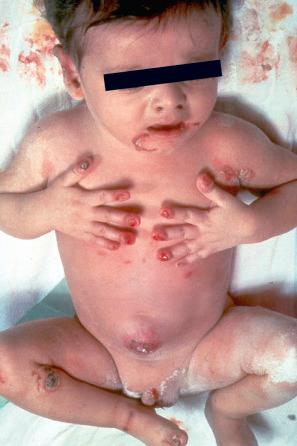
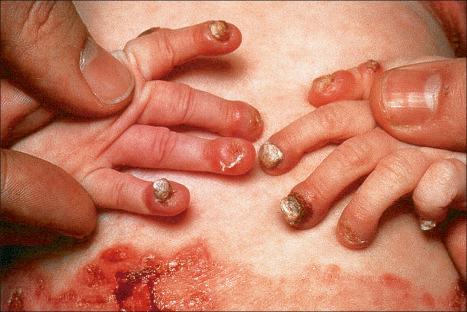
The early clinical course of this subtype of junctional EB may be similar to the generalized severe variant, but the patients usually survive to adulthood. There is a gradual lessening in blistering severity with age. Mucous membranes are involved, and the teeth show severe enamel defects or may fail to erupt normally. Nails are often dystrophic or missing. Atrophic scarring is characteristic. There is also alopecia affecting the scalp, eyebrows, and eyelashes, and body hair is also sparse or absent. Large pigmented nevi, or acquired macular hyperpigmented lesions, are typical. In this type of junctional EB, it is common to observe small patches of skin that do not blister; this phenomenon is called revertant mosaicism (also known as natural gene therapy), and represents a spontaneous correction of one copy of the mutant gene.
This is a rare subtype of autosomal recessive junctional EB that overlaps with generalized intermediate junctional EB, except that the onset of symptoms is delayed – often not starting until childhood, typically between 5 and 8 years of age. Initially, the trauma-induced blisters mainly occur on the hands and feet, although they may be preceded by nail dystrophy. Later, knees and elbows are involved. Progressive atrophic changes lead to early loss of fingerprint patterns and mild finger contractures. The tooth enamel may be defective and the tongue papillae may disappear. The oral mucosa is sometimes involved.
Blistering is usually present at birth, following a pregnancy complicated by polyhydramnios. The lesions are usually widespread and can result in atrophic scarring ( Fig. 4.16 ). The teeth are hypoplastic, lacking normal enamel, and the nails are dystrophic. Early attempts at feeding result in vomiting. The majority of cases do not survive early infancy. In those children who survive, other features include haematuria, dysuria, and recurrent urinary tract infections. The pyloric canal is often completely obliterated ( Fig. 4.17 ) and requires surgical correction although the nature of the underlying molecular pathology usually influences prognosis.
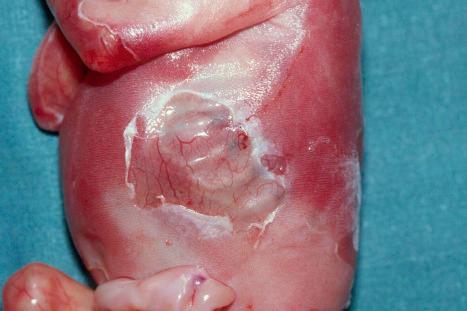
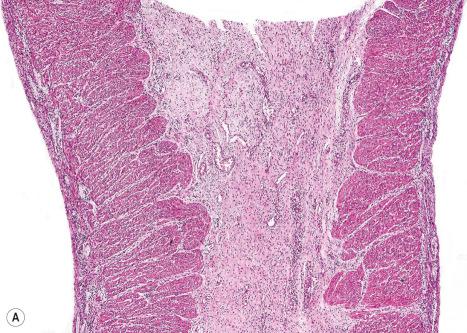
This is a recent addition to the classification of junctional EB. The features comprise congenital nephrotic syndrome, interstitial lung disease, and skin fragility, due to autosomal recessive mutations in α3 integrin. The renal and respiratory features predominate clinically, and skin blistering may be a minor feature that only occurs later. The oral mucosa is not involved. The scalp hair, eyebrows, and eyelashes are fine and sparse and nails may be dystrophic. Prognosis is poor with recurrent lung infections and multiorgan failure consistent with the known distribution of α3 integrin in several tissues.
Localized forms of junctional EB occur: typical clinical manifestations include nail dystrophy, dental enamel changes, and blistering involving the lower legs and feet only. In some individuals, chronic, painful erosions associated with hyperkeratosis develop on the soles, although it is not clear why the lower legs should be a predilection site for blistering. In some cases, blistering starts in neonates, while in others there may be late-onset disease.
In the neonatal period in the rare inversa subtype of localized junctional EB, the whole skin may be fragile with generalized blistering. Later, however, the lesions affect chiefly the groins, perineum, and axillae, hence the description of ‘inversa.’ Healing may result in small, atrophic white streaks. Dysplastic teeth, erosions of the cornea, and feet and nail dystrophy are all features. Why there should be a preference for flexural site involvement is not known.
This subtype of junctional EB starts in infancy with chronic erosions affecting the face (mainly around the nose and mouth) although erosions are also seen on the limbs, trunk, and genitalia. The nails are also involved with marked periungual and subungual inflammation and a universal feature is hoarseness. The teeth may be notched. There is prominent skin and mucosal granulation tissue that can lead to delayed wound healing, laryngeal obstruction, and blindness. The disorder results from autosomal recessive mutations in a particular splice variant of the laminin α3 polypeptide.
Dystrophic EB can be autosomal recessive or autosomal dominant ( Table 4.4 ). Clinically, dystrophic EB is characterized by skin fragility, blistering, scarring, nail dystrophy, and milia formation. Mucosal involvement is common and erosions and scarring can affect the mouth, esophagus, genitalia, and anus. There may be clinical overlap between some cases of recessive and dominant dystrophic EB, which can make genetic counseling difficult, particularly in sporadic cases. The most recent classification of EB no longer contains any eponymous subtypes, and also recognizes that the phenotypic appearances vary considerably between patients and that, given the spectrum of clinical appearances, diagnostic labeling within an individual category can be somewhat arbitrary in some cases.
Blisters in dominant dystrophic EB mainly occur following trauma to the skin overlying the bony prominences, such as the knees and ankles, and dorsa of the hands or feet ( Fig. 4.18 ). The most consistent findings are localized scarring with milia formation and dystrophic nails. Nail dystrophy is probably the most important diagnostic feature of the disease, especially in adults, because many patients have only limited blistering and scarring, which becomes less noticeable with age. Blistering in the mouth is usually mild and the teeth are generally normal. However, perianal lesions may cause considerable pain, especially in children. Terms such as Bart syndrome are obsolete. Cutaneous features, such as albopapuloid lesions, once thought to be pathognomonic for subtypes of dominant dystrophic EB, are now recognized to occur in several forms of dystrophic EB.
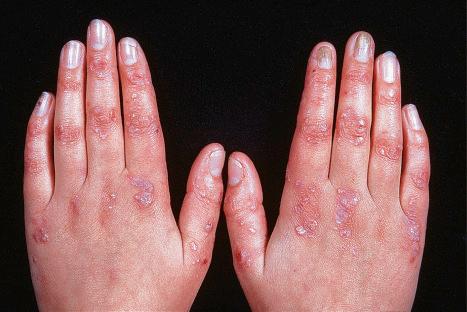
The nature of this subtype of dominant dystrophic EB is not precisely defined as the term ‘acral’ is not widely used in the published literature. Its inclusion in the latest classification of EB is to assist description of those cases of dominant dystrophic EB with a more localized pattern of skin involvement, usually involving the hands and feet ( Fig. 4.19 ). However, the word acral is used in preference to localized because some oral or esophageal involvement can occur despite the relative lack of involvement of much of the skin. Trauma-induced blistering, scarring, and milia are typically present in acral skin.

This subtype of dystrophic EB may be inherited by either autosomal dominant (the majority) or autosomal recessive transmission with considerable overlap in appearances. Clinically, there are blisters, atrophy, and scarring on the shins ( Fig. 4.20 ). Lesions are usually violaceous, sometimes mimicking lichen planus. Nails on both the hands and feet tend to be dystrophic. The shins may be itchy and the phenotype can overlap with dystrophic EB pruriginosa (see next section). Clinical signs are not exclusively confined to the shins and relatively minor skin fragility, scarring, and milia may be detected at other body sites, particularly over bony prominences.

This subtype of dystrophic EB overlaps clinically with the pretibial variant. The main difference is the intense pruritus, the etiology of which is uncertain. Studies have excluded concomitant atopy and a range of possible metabolic, biochemical, and endocrine factors in disease pathogenesis. The clinical features can resemble hypertrophic lichen planus or nodular prurigo or autoimmune inflammatory blistering, or even dermatitis artefacta. Like the pretibial subtype, the initial onset of symptoms and signs may be delayed for several decades, often leading to a genetic cause for the skin lesions being erroneously discounted. Although the shins are often involved, pruritic skin lesions can occur at any site.
This condition is often only first diagnosed when a family member presents with trauma-induced skin blistering, and a review of the pedigree reveals one or more generations of other individuals with nail dystrophy, but no history of blisters, scarring, milia, or mucosal erosions. Thus, in some individuals there are no clinical signs present apart from nail dystrophy, which can sometimes just be confined to the great toenails, and therefore in many families, a subtype of dystrophic EB is not suspected at all. This variant of dominant dystrophic EB is therefore likely to be much more common than is currently appreciated.
Become a Clinical Tree membership for Full access and enjoy Unlimited articles
If you are a member. Log in here